#Job Board HTML Template
Explore tagged Tumblr posts
Text
Jobify - Job Board, Freelance Market HTML Template
Introducing Jobify - the ultimate job board and freelance market HTML template built with the latest Bootstrap framework. Crafted to perfection, Jobify offers a seamless user experience that will revolutionize the way you connect employers with top talent.
Featuring a sleek and modern design, Jobify provides a visually stunning platform that immediately captures the attention of your visitors. With its intuitive navigation and responsive layout, job seekers and freelancers can effortlessly browse through a vast array of opportunities, tailoring their search to their specific needs.
Read More - https://www.templatemonster.com/website-templates/jobify-job-board-freelance-market-html-template-441224.html
0 notes
Text
The Ultimate Guide to Hiring Django Developers in 2025
If you’re building a scalable, secure, and high-performing web application in 2025, Django remains one of the best frameworks to use. But to unlock its full potential, you need to hire Django developers who understand how to use this Python-based framework to meet your business goals.

Why Choose Django in 2025?
Django is still a top choice for web development in 2025 due to:
Rapid Development: Built-in admin panel, ORM, and modular architecture
Scalability: Used by companies like Instagram, Spotify, and NASA
Security: Protection against XSS, CSRF, and SQL injections
Community Support: A mature and well-documented ecosystem
When Should You Hire a Django Developer?
You should hire Django developers if:
You need to build a custom web application or CMS
You’re planning a secure eCommerce site
You require API development for mobile/web apps
You want a high-performance MVP or startup product
You need a secure backend for SaaS or enterprise software
Key Skills to Look For
Before hiring, make sure the Django developer is skilled in:
Python programming
Django framework (ORM, views, forms, templates)
REST APIs (DRF — Django REST Framework)
Front-end integration (HTML, CSS, JavaScript, React/Angular)
Database systems (PostgreSQL, MySQL, SQLite)
Version control (Git)
Deployment (Docker, AWS, CI/CD)
Hiring Options: Freelancer vs Agency
Option Pros ConsFreelancer Cost-effective, flexible Limited availability, may lack team supportAgency (like Oodles)Scalable, full-stack team, support & QASlightly higher cost
If you want a full-cycle development solution with guaranteed timelines and post-launch support, hiring through an agency is ideal.
Interview Questions to Ask
Here are a few practical questions you can ask during the interview:
What’s the difference between a Django model and a Django form?
How would you handle user authentication in Django?
Explain the role of middleware in Django.
What are signals in Django and when should you use them?
How do you optimize Django for performance?
How Much Does It Cost to Hire Django Developers in 2025?
Freelancers: $20 — $60/hour (based on location & experience)
Agencies: $25 — $100/hour (comes with project managers, QA, and design support)
Dedicated Developer (Full-Time): $2000 — $6000/month
Outsourcing to countries like India gives you access to highly skilled developers at lower cost without compromising quality.
Where to Find Django Developers?
Freelance Platforms: Upwork, Freelancer, Toptal
Developer Marketplaces: Turing, Arc, Gun.io
Agencies: Oodles — Hire Django Developer
Job Boards: StackOverflow, GitHub Jobs, Remote OK
✅ Final Thoughts
Hire Django developers in 2025 is about more than just technical skills. You need someone who understands your business vision, works well with your team, and builds secure, scalable web applications with future growth in mind.
Whether you’re launching a new product, upgrading your tech stack, or expanding your backend, make sure you hire a Django developer who brings value from day one.
Looking to hire Django experts? Partner with Oodles for experienced Django developers who deliver quality, speed, and security.
0 notes
Text
Building a Personal Website: Why It Matters for Your Career
Why build a personal website? Simple — because your online first impression matters more than ever. Try Goggling your name. What shows up? For most people, it’s a scattered mix of LinkedIn profiles, social media posts, and maybe an old photo from college. But imagine if, right at the top, a sleek personal website popped up — your own digital space, crafted by you. That’s how you stand out. It’s the smart way to boost your visibility and set the stage for real career growth with website power.

Now let’s dig into why having a personal website is becoming a must-have, especially if you’re in tech, design, writing, or any career where showing your work speaks louder than a résumé.
Show, Don’t Just Tell — The Portfolio Power Move
You know what’s cooler than saying “I’m a web developer”? Showing a slick site you built with your own code. When you showcase portfolio online, you’re not just listing skills, you’re proving them. A website lets you display your projects, case studies, testimonials, and all the tech you’ve touched — right in one clickable place.
And the best part? You control it. No weird layout restrictions or profile updates lost in a sea of job boards. You get to highlight your personal branding for developers, writers, marketers — whoever you are. That brand is you, and your website is your 24/7 personal hype machine.
Still wondering why build a personal website? Think of it as your home on the internet. Social media platforms come and go, but your domain name sticks with you. It’s your turf, your vibe, your digital legacy. Future you will thank present you.
Boost Career Confidence and Get Found
Here’s a fun fact: recruiters and clients Google candidates. All. The. Time. Now, imagine their surprise when they find a sleek, updated site with your story, your work, and a killer blog on career tips. That’s a chef’s kiss moment.
This is where career growth with website gets real. Your personal site doesn’t just display your work — it increases your chances of being found online. Add some smart keywords (like “JavaScript developer in Seattle” or “UX designer with SaaS experience”), and suddenly you’re on someone’s radar.
A well-built website can be the ultimate web development career tip in disguise. You show off your tech stack, your creativity, and your communication skills — all in one go. And if you’re using the Coding Brushup personal website guide, you’re setting yourself up for a smart, structured, and polished result.
Stand Out, Stay Sharp, and Get Hired
Having your own website screams, “I take my career seriously.” It’s a subtle yet powerful signal that you’re proactive, organized, and resourceful. You’ve taken the time to craft your online presence — not just throw together a résumé. That’s a big green flag for clients and hiring managers alike.
And guess what else? It sharpens your skills. Whether it’s HTML, CSS, writing copy, or organizing a portfolio, building your site forces you to level up. It’s hands-on learning at its best. This is one of those personal website benefits that people often overlook: you grow while building it.
Plus, you can blog! Share insights, document projects, write about your coding journey or challenges you’ve faced. With each post, you’re not only helping others — you’re showing thought leadership. And yep, that’s another boost for your career growth with website as a tool.
Final Thoughts from Coding Brushup
If you’re serious about building your tech career, a personal website isn’t optional anymore — it’s your secret weapon. And no, it doesn’t have to be fancy. Even a simple, clean site with your name, projects, contact info, and a few fun facts can set you apart.
Need help getting started? The Coding Brushup company website has tutorials, templates, and guides designed to walk you through each step. Whether you’re a total beginner or a dev brushing up on skills (hey there, Codingbrushup personal website guide fans!), we’ve got your back.
So grab a domain, pick a template, and start building. You’re not just creating a website — you’re investing in you.
0 notes
Text
Also known as diagrams, user flow or UX flow defines a complete user journey or path when availing a service or product; all the way from the beginning. Each and every step a user takes is then mapped to the point of final integration based on all possibilities and challenges that may come across. All that said, a user flow is important to transactions or conversions with a complete process based on communication technology or platform that can be a website, mobile app, or any other. Because user flow has a direct impact on the overall experience, having a high-end, premium and authentic design is extremely important. Now that we have a basic understanding of user flow, let’s explore some of 2021’s best tools to help you out with the entire process that is also used by leading web design Dubai agencies. Wondershare Mockitt With a full suite of handy flowchart, design, and prototyping tools, Wondershare Mockitt takes the lead when it comes to super amazing user flows that may fall anywhere between simple to sophisticated and extreme pro-level. The platform also supports sharing the data with project managers as well as real-time implementation in the design of prototypes. This way, testing, and development can take place instantly to get the job done in a smooth and swift manner. Important Features A wide range of creative assets library including flowchart elements, connectors, and hundreds of supporting components. Editable user flow and flowchart templates. Drag-and-drop functions for quick and clean user flows Support Sketch design and prototype import for better user interaction Easy downloading as HTML packages and online sharing Weje With free infinite online whiteboards from Weje anyone can cope with framing user flows: from a sole entrepreneur or novice marketer to a salted salesman or creator. Design a user flow of varying complexity, either on your own or with the help of a team. Weje offers much for collaboration, including shareable canvases, named cursors, and chat. You can set connections between different elements with arrows or use a mind map-making tool - to comfort the process. Also, you can copy & paste media or figures right onto the board and after - edit and group these, as needed. Important Features Templates library and a built-in mind map maker. Online sticky notes, checklists, and a drawing tool that ease simultaneous editing. A convenient drag and drop tool for effortless work with text and images. An option to download the outcome or share it via email or socials. Figma Another famous design and prototyping platform as well as an effective user flow creating tool. When comparing cost with many other design tools, Figma is a bit expensive but totally worth it. With a large community of designers, creative agencies, and third-party users, Figma lets them contribute outstanding content in terms of a design system, plugins, UI kits, and much more. Plus, you can also import Sketch and Adobe XD files and prototype them. Important Features Massive asset repository that also includes third-party UI kits and user flows. Ready to deploy templates and components with the Flowchart Maker. A greater number of tools for developing creative designs, prototypes, and user flows. The convenience of Autoflow plugin for user flow creation. Additional option to embed flowcharts in Dropbox Paper. Miro Taking design to a whole new level is Miro; a digital whiteboard with ready-to-use diagramming and mapping tools, allowing you to brainstorm and proceed to create outstanding user flows, customer journey, flow charts, and much more. It’s quite a handy tool to let you collaborate on design flows with users, share each other's work, edit and implement in real-time as well as offline. Important Features Ready-to-use widgets and components. Frameworks and templates for a quick start. A complete package of commenting and annotation tools. Integrates with many other design tools such as Sketch, Slack, and more.
Overflow Claiming itself as the world's first user flow and diagramming tools customized specifically for product designs. It works differently from many other digital design tools in a way that lets you work and sync even in offline mode. Overflow also offers integration with many other design platforms letting you merge your designs with the least effort. Important Features Customized and comprehensive flowchart elements. Also, link design layers with app screens. Allow style editing for balancing fonts, text size, and other features with design. Different device skins. Able to split primary user flow into its subcomponents and further divide them into the individual artboard. Lucidchart Holding true to specifically being a flowcharting and workflow tool, Lucidchart lets you conveniently draw the shapes and style them the way you like as per the branding guidelines. With this, the tool also lets viewers follow the entire process for a more immersive and real-time presentation. Lucidchart comes with premium enterprise-grade features like converting CSV to the org chart, import OmniGraffle, Visio, and many others for easy enterprise and user management. Important Features Various style options for consistency between designs and user flows. For neat and clean diagrams, there’s an option for smart lines. For larger canvas, there’s an option to go full-screen. Handy containers for task management and separating them. Real-time annotation and commenting features to let you and others add notes. Wireflow As an online and open-source tool, Wireflow lets you create user flows without any Photoshop skills for maximum ease. In addition, it also offers users above a hundred built-in customized graphics. Like many other tools, Wireflow also allows real-time collaboration with users and friends to double up the speed and effort of creating and sharing amazing user flows in real-time. Important Features Allow designing project rooms/virtual chambers for better project management. The simple and user-friendly tool with high-end essential features to ensure a sure win user flow design. Timblee Works perfectly on both desktop devices as well as mobile, Timblee assists in developing user flow diagrams in the early stages of product development while eliminating the hassle of complex tools in between. On subscription, you’ll get a 14-day trial period. Many website design companies in Dubai, as well as worldwide, are using Timblee so that adds to the must-have factor. Important Features Convenient designing of the sitemaps. Excellent for beginners because of the drag-and-drop canvas. Real-time feedback on work without any restriction to have a Timblee account. There’re many different UX tools and more are expected to surface as we move ahead in the year. For now, you can try out any of the tools listed above to create amazing user flows and take the winning.
0 notes
Text
How to Hire the Right HubSpot CMS Developer for Your Business
In today’s digital landscape, having a well-designed, high-performing website is crucial for businesses aiming to attract and retain customers. HubSpot CMS (Content Management System) has become a popular choice for creating scalable, user-friendly websites that integrate seamlessly with marketing, sales, and customer service tools. But to truly leverage the power of HubSpot CMS, you need the expertise of a skilled developer. In this article, we’ll guide you through everything you need to know about hiring a HubSpot CMS developer to elevate your online presence.
What is HubSpot CMS?
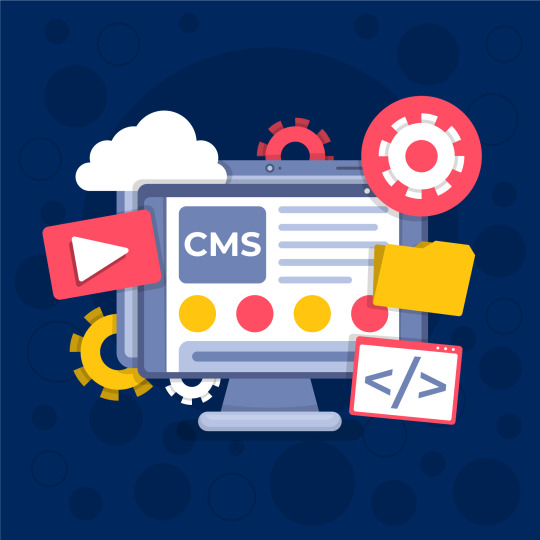
HubSpot CMS is a robust content management system designed to help businesses create, manage, and optimize their websites with ease. It’s part of HubSpot’s larger ecosystem, which includes tools for CRM, marketing automation, and customer service.
Some key features of HubSpot CMS include:
Drag-and-drop editing for easy page building.
Integrated SEO recommendations to improve search engine rankings.
Advanced personalization features to tailor user experiences.
Seamless integration with HubSpot’s CRM for better lead management.
Whether you’re building a new website or enhancing an existing one, HubSpot CMS offers unparalleled flexibility and scalability. However, to fully harness its potential, hiring a HubSpot CMS developer is essential.
Why Do You Need a HubSpot CMS Developer?
While HubSpot CMS is user-friendly, customizing it to meet specific business requirements often requires technical expertise. Here are some reasons to hire a HubSpot CMS developer:
Custom Development: Developers can create tailored templates, themes, and modules that align with your brand and business goals.
Website Optimization: Skilled developers ensure your site is fast, mobile-friendly, and SEO-optimized.
Integration: A HubSpot developer can integrate your website with third-party tools, APIs, and HubSpot’s CRM to streamline workflows.
Troubleshooting and Maintenance: Developers provide ongoing support to resolve issues and keep your site updated.
Key Skills to Look for in a HubSpot CMS Developer
When hiring a HubSpot CMS developer, look for the following skills:
HubSpot Expertise: Familiarity with HubSpot’s CMS Hub, Design Manager, and custom modules.
Proficiency in Coding: Strong knowledge of HTML, CSS, JavaScript, and HubL (HubSpot’s Markup Language).
SEO and Performance Optimization: Ability to implement SEO best practices and ensure optimal site performance.
API and CRM Integration: Experience integrating HubSpot CMS with other systems and applications.
Creative Design Skills: Understanding of modern design principles for creating visually appealing and user-friendly websites.
Problem-Solving and Communication: Ability to troubleshoot issues and collaborate effectively with stakeholders.
How to Find the Right HubSpot CMS Developer
Finding the perfect HubSpot CMS developer requires exploring the right platforms and vetting candidates thoroughly. Here are some options:
Freelancers vs. Agencies: Decide whether you need a freelancer or an agency. Freelancers are cost-effective for smaller projects, while agencies provide comprehensive services for larger, more complex tasks.
Freelancer Platforms: Browse platforms like Upwork, Fiverr, and Toptal for freelance HubSpot developers with verified reviews and portfolios.
HubSpot Solution Partners: Explore HubSpot’s directory of certified solution partners for specialized developers and agencies.
Job Boards and Social Media: Use LinkedIn, Indeed, and other job boards to post openings or connect with developers.
Referrals and Portfolios: Ask for recommendations from peers and review candidates’ past work to assess their capabilities.
Questions to Ask Before Hiring a HubSpot CMS Developer
To ensure you’re hiring the right person, ask these key questions:
What experience do you have with HubSpot CMS Hub?
Can you provide examples of custom templates or modules you’ve developed?
How do you approach optimizing websites for SEO and performance?
Are you familiar with HubSpot’s APIs and CRM integration?
Do you offer ongoing support and maintenance services?
What is your estimated timeline and budget for this project?
These questions will help you evaluate the developer’s technical skills, experience, and approach to projects.
Budgeting for a HubSpot CMS Developer
The cost of hiring a HubSpot CMS developer varies based on factors such as experience, project complexity, and location. Here’s a general breakdown:
Freelancers: Rates typically range from $50 to $150 per hour.
Agencies: Project costs can start at $5,000 and go up depending on the scope.
Consider your project’s requirements and balance cost with quality to ensure the best results.
Benefits of Hiring a HubSpot CMS Developer
Tailored Solutions: Create a website that meets your specific business needs and goals.
Enhanced Performance: Optimize your site for speed, SEO, and mobile responsiveness.
Seamless Integrations: Ensure smooth connectivity between your website, CRM, and third-party tools.
Ongoing Support: Receive regular updates, troubleshooting, and maintenance.
Improved ROI: A professionally developed site boosts user engagement and conversions.
Managing Your HubSpot CMS Development Project
To ensure a successful project, follow these tips:
Define Goals: Clearly outline your objectives and deliverables.
Use Project Management Tools: Tools like Trello or Slack can streamline communication and task management.
Regular Testing: Conduct thorough testing during development to identify and resolve issues early.
Monitor Post-Launch: Track performance metrics and gather user feedback to improve your website continuously.
Common Mistakes to Avoid When Hiring a HubSpot CMS Developer
Choosing Based Solely on Price: Don’t compromise on quality to save costs.
Skipping Portfolio Reviews: Always review past work to gauge expertise.
Ignoring Maintenance: Ensure the developer offers post-launch support.
Unclear Project Scope: Define your requirements clearly to avoid misunderstandings.
Neglecting SEO: Ensure the developer prioritizes SEO and performance optimization.
Conclusion
A skilled HubSpot CMS developer can transform your website into a powerful tool for driving business growth. By focusing on customization, performance, and seamless integrations, you can create a website that not only looks great but also delivers exceptional user experiences. Take the time to find the right developer who aligns with your goals, and enjoy the long-term benefits of a professionally developed HubSpot CMS site.
Ready to take your website to the next level? Contact us today to hire an experienced HubSpot CMS developer and unlock your website’s full potential!
1 note
·
View note
Text
Hire AngularJS Developers: A Complete Guide for 2024

As the digital landscape continues to evolve, businesses are increasingly relying on robust web applications to enhance their online presence. AngularJS, with its powerful features and versatility, remains a top choice for many enterprises. If you’re looking to hire AngularJS developers, this guide will walk you through everything you need to know for 2024.
Why Hire AngularJS Developers?
AngularJS, a JavaScript-based open-source front-end web framework, is maintained by Google and a community of individuals and corporations. It allows developers to use HTML as the template language and extend HTML’s syntax to express the application’s components clearly and succinctly. Here are a few reasons why hiring AngularJS developers is beneficial:
Efficient Development: AngularJS simplifies the development process by providing a structured framework. This makes it easier to develop, test, and maintain code.
Rich Features: With features like two-way data binding, dependency injection, and directives, AngularJS developers can create dynamic and interactive web applications.
Community Support: Being backed by Google, AngularJS has a vast community of developers, ensuring regular updates and a wealth of resources.
Scalability: AngularJS is suitable for both small and large-scale applications, making it a versatile choice for businesses of all sizes.
Key Considerations When Hiring AngularJS Developers
When looking to hire AngularJS developers, it’s crucial to consider several factors to ensure you find the right fit for your project:
Experience and Expertise: Look for developers with extensive experience in AngularJS. Check their portfolio to see the types of projects they have worked on.
Technical Skills: Ensure they have a strong grasp of JavaScript, HTML, CSS, and other relevant technologies. Familiarity with AngularJS-specific tools and libraries is also essential.
Problem-Solving Abilities: A good developer should be able to tackle challenges and find effective solutions quickly.
Communication Skills: Effective communication is vital for the success of any project. Ensure the developer can clearly articulate ideas and collaborate with your team.
Cultural Fit: Consider whether the developer aligns with your company’s values and work culture.
How to Hire the Best AngularJS Developers
Finding the right developer can be a daunting task. Here’s a step-by-step process to simplify your search:
Define Your Requirements: Clearly outline the project scope, objectives, and technical requirements. This will help you find a developer with the right skill set.
Source Candidates: Use job boards, professional networks, and hiring platforms to find potential candidates. Consider partnering with a reputable development company like Verve Systems.
Screen and Interview: Conduct thorough interviews to assess the candidates’ technical abilities, experience, and cultural fit. Use practical tests and real-world scenarios to evaluate their problem-solving skills.
Check References: Speak with previous clients or employers to get insights into the developer’s work ethic and reliability.
Negotiate Terms: Discuss the terms of employment, including project timelines, compensation, and any other pertinent details.
Why Choose Verve Systems?
At Verve Systems, we pride ourselves on being the best AngularJS development company. Here’s why you should consider hiring our developers:
Expertise and Experience: Our developers have extensive experience in AngularJS and have successfully delivered numerous projects across various industries.
Comprehensive Services: From initial consultation to deployment and maintenance, we offer end-to-end AngularJS development services.
Quality Assurance: We follow rigorous quality assurance processes to ensure that every project meets the highest standards.
Client-Centric Approach: We prioritize our clients’ needs and work closely with them to deliver customized solutions that drive results.
Competitive Pricing: We offer flexible pricing models to suit different budgets without compromising on quality.
Conclusion
Hiring the right AngularJS developer is crucial for the success of your web development project. By following the steps outlined in this guide, you can find a skilled developer who meets your requirements and can help you achieve your business goals. If you’re looking for a reliable partner, Verve Systems is here to provide top-notch AngularJS development services.
Contact Us — +1 (732) 402–6854, +91 79 4000 7881
Enquire Now — [email protected]
0 notes
Text
https://mediapasta.training/web-development-training-in-thane/
Web Development Training In Thane
Mediapasta has the best of Digital Marketing, Thane, where we consistently try to come up with new skills to learn everyday. Our faculty has improved the learning of Web Development Training in Thane where now students can not only get sharpened to skills of Full Stack Developer but also can have practicals on how the industry work.
The web development industry has grown at a rapid speed since the commercialization of the web. For web developers and designers, this has created a tremendous potential. Full stack web developer, backend web developer, and Frontend web developer were among the top developer occupations worldwide in the survey conducted in 2016.
In the year 2017, web developer was the first option for developers with 72.6% occupancy in the available positions amongst various developer roles.
Why do Web Development Training?
Highly Wanted-After Work. Web development has become one of the most sought after jobs.
The high-paying work industry.
Be a boss of your own.
Remotely Function.
Enhance Your Imagination.
A nice experience and an interesting work.
Upgrade your problem-solving skills.
A Potential Work for the future.
Some advances of being a Web Developer
If you are a quick learner and flexible with programming languages, web development and enhancement is an awesome field as a profession. One more purpose of having web development as a career is that you might work as a freelancer as well.
Our Key Highlights for Training :
Sped up Training – All training courses are intended to be completed within a period of 4-8 weeks. In order to transform you into a web ninja, we have you on board ASAP.
Trendy Technologies – All our courses are developed by professionals to include the industry’s most trendy technologies that will help you find the best career opportunities with ZERO compromise.
Experts in Industrial sector – We say, “To learn from the experts to become a professional.” All of our training workshops are organised by industry experts.
Intern Opportunities – We recommend the best internship opportunities at leading web agencies & startups after training sessions.
The Mediapasta Training Institute for Digital Marketing specialises in offering Web Development courses in Thane, Mumbai. For both traditional and sensitive website design, publishing and maintaining websites for both private and professional use, the web design training provided offers critical information and proper skills. For this course, no previous knowledge of web design, HTML or WordPress is needed.
You can learn how to design page templates, create web pages with HTML, style pages with wordpress, and add Google maps and YouTube videos as one of the top Web Development Institutes in Thane. Our web design curriculum also teaches HTML5, At our web design courses, our experienced trainers will direct and assist the students to know how to work with these resources and also encourage them to create apps, test functionality and host the website.
We provide learning about Managed WordPress & WooCommerce Service. On our cloud servers, you can learn how to host your WordPress sites and enjoy stunning results and a managed service.
Start Simple & Updates Managed
For new and existing sites, our cloud plans provide quick onboarding and managed auto-updates for WordPress and WooCommerce. Find Out More
Git & WP-CLI, Staging
With a convenient staging tool and Git and WP-CLI integration, we promote your WordPress and WooCommerce production flow. Find Out More
Caching Dynamic & More
Speed up your WordPress and Woo sites by smart dynamic caching and several other performance enhancements with our SG Optimizer plugin.
0 notes
Photo
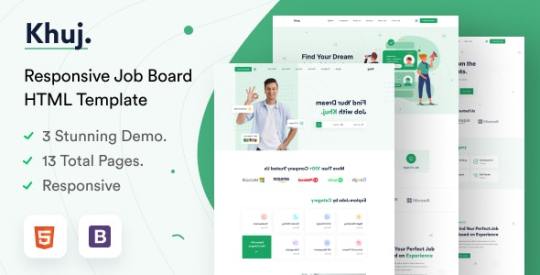
New Post has been published on https://themesnulled.us/khuj-job-board-html-template/
Khuj - Job Board HTML Template
0 notes
Text

Your job posting just got a major upgrade 💪
With our new freebie, your recruitment process just got a whole lot easier. This job posting template is responsive, professional, and most importantly, designed to attract the best candidates out there.
Don't wait any longer, download it now and start hiring the best of the best!
👉👉👉 https://devstoc.com/post?p=hiresy-responsive-job-board-html-website-template
1 note
·
View note
Link
HireUs is one such HTML template, which leads you closer to achieving your goals. It is designed in such a way that one can use it without any trouble.
1 note
·
View note
Text
Responsive Admin Dashboard Template with UI Kit - Career
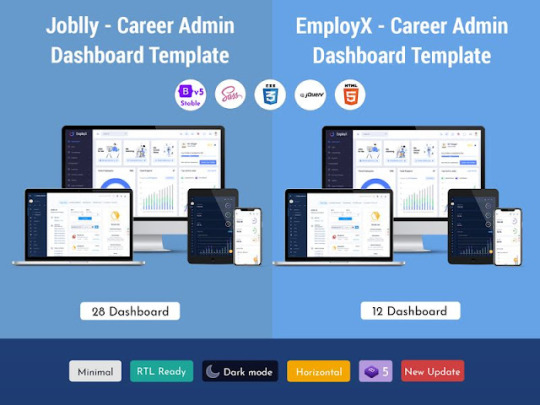
Career - Responsive Admin Dashboard is a very unique HTML dashboard that can be used for online applications for jobs, career app and software. It also has many amazing features like Application Tracker, Jobs, monthly report and performance tracking. This Bootstrap HTML Template is a clean way to use the design for your dashboard projects, too. Have you ever thought that the career admin Dashboard template can be used for admin dashboard applications for the online applications, too? Also, one can easily track and analyze the job statistics from the HTML-template plugins and widgets.

Read More : https://multipurposethemes.com/blog/responsive-admin-dashboard-template-with-ui-kit-career/
#Admin Dashboard#Admin Dashboard responsive template#admin dashboard template#Admin Dashboard UI Kit#admin panel#admin panel interface#admin template#backend dashboard#Bootstrap Admin HTML#Bootstrap Admin Template#Bootstrap 5 Admin Templates#Bootstrap Admin Web App bootstrap dashboard#job board HTML template#job portal#Premium Admin Template#premium bootstrap templates#Responsive Admin Dashboard
0 notes
Link
#Website Designing#job website templates#html templates#latest website templates#job board website templates#best website templates#uk website templates
1 note
·
View note
Text
Marquita Wiggins is Developing her Open Source Graphic Design Program: Designy
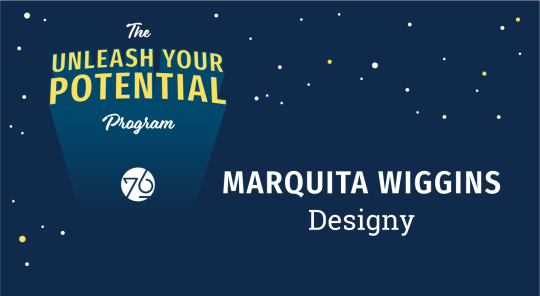
The Unleash Your Potential Program provides a System76 computer to six winners for accelerating the completion of their next project. This week, we interviewed Marquita Wiggins, who is in the early stages of developing her open source Canva alternative, Designy.
What prompted you to want to create Designy?
I like Canva, but because it’s owned by a company that keeps the software closed down, there’s no ability for people who know how to code to be like, “Oh, I want this. Let’s add it and make Canva even better.” To my knowledge, there aren’t any free tools out there that give the Canva Pro treatment. So I’d like to make a tool that’s better, and also free.

You mentioned you had heavy experience using Canva. What’s your background with it?
I work in marketing for WBEZ, a public radio station. I’ve been doing that for about three years. A good portion of my work involves designing, so I’m always in either Canva or Illustrator.
I like the ease of Canva because I can work on designs from my work laptop, or I can use someone else’s laptop and log in if I’m somewhere else. And then with Illustrator, you can expand artboards as much as you want.
What sorts of improvements are you implementing in your open source alternative?
When you’re working on a design in Canva, it’s very linear. Let’s say I am working on a poster, and I just started it, and I just want to keep iterating on small changes. In order to do that, you have to locate the artboard that you’re working on, and you can’t view them all on the board at the same time. The reason I like Illustrator is I like to have eight different artboards up at the same time, and I can zoom out and see all my iterations at the same time, and then zoom into the one I want to make changes on. That is my number one feature that I love about Illustrator, and that’s what I want to bring to Designy.
I’d also give Designy the ability to create templates and share them with other people on the same software. If you create a template, you can then put it on the template board for other people to use. In Canva, you can’t just put templates up in the marketplace. Canva creates your templates, and those are the only ones you’re able to see unless you know somebody who also uses Canva, and they send you the template to use.

Do you have a background in coding?
Not really. In my last job I sent out all the emails for the organization, and I also managed the website, so I did use HTML and CSS for that, but I was never an expert in it. That said, I was an expert Googler. I was able to make massive changes to the website by Googling what I needed to do and then figuring out the code for it.
I’ve been interested in the computer programming space for a while, and I’ve always dabbled in it and learned more about HTML and CSS. When I saw this program pop up, I felt that this was my opportunity to learn a lot more, and also be able to create something that would be useful to myself.
What software are you using to develop it?
I’m going to be using Javascript for the front end, Java for the back end, and likely MonoDB for the database. I’m almost done learning Javascript now, and it’s a lot! So after that, I’ll start building the front end of the site, and then learn Java, connect it to the back end, and then MonoDB for the database.
This was the perfect opportunity to get the momentum going on learning how to do this, because now I can’t stop until it’s done!
Why did you choose Javascript?
When Canva was created, they created it using Javascript, so I figured why not use the same software that they originally used? I think right now they’ve moved on to something else, but when they originally started they used Javascript.
What are your initial thoughts on Pop!_OS?
I never used Linux until I got this laptop, so it was a bit of a learning curve to figure out how to do certain things. I haven’t really downloaded that much—I only really use Visual Studio Code and Firefox, and I also downloaded the Brave browser on it—but I like the navigation. I like that I can open up Visual Studio Code and then open up Firefox and the auto-tiling will automatically arrange the windows. I wish more companies would develop that feature.

How has your experience been with the Oryx Pro so far?
It’s great! It has a huge screen, so I don’t even have to use an external monitor. I have it on a riser with an external keyboard. I haven’t had any issues so far.
Did you encounter any challenges in setting up your system out of the box?
It was super smooth. I don’t even know if it took 15 minutes from unboxing it to actually being able to use it. I also like that I’m able to secure my data with encryption before I log into my account.
You mentioned Designy will have a beta. What’s the plan for that currently?
I’m thinking the beta phase will start in March when it’s all done, where I’m sharing it with other people, getting feedback, and making changes. I’ll be using Reddit a lot to get folks to try it out and let me know what they think. It’ll also be up on GitHub, so people will be able to push updates if they have a change they want me to make.
I’m going to finish the front end of the site in November and the back end of the site will be done in January. The database connection will be done in February. I know there may be a lot of weird bugs and whatnot that other people will find, so the beta helps me work all that out. The goal is to put this out to the public and then iterate on it, so maybe down the line it’ll transition from Javascript to something else.

Is there anything we didn’t ask about that you wanted to share?
A random fact is I have a dog named Mr. President. People seem to get a kick out of that.
Stay tuned for further updates from Marquita Wiggins’ Designy and other cool projects from our UYPP winners!
#system76#Pop!_OS#open source#laptop#software#software development#design#graphic design#Designy#Canva#Illustrator#linux#ubuntu#WBEZ#radio#MonoDB#Java#Javascript#Reddit#GitHub#HTML#CSS#Unleash Your Potential Program#unleash your potential#VSCode#Firefox#Gazelle#dog#Brave browser#STEM
36 notes
·
View notes
Photo

After a few years of trial and error, I think I've finally found the perfect organization method.
In the early years of high school, I had a bullet journal. I was an artsy kid who found a way to combine art with organization in a way that benefited other parts of my life.
However, as I approached the end of high school, my schedule got busier, and I was involved in a lot more things, so owning a bullet journal was less practical. Because of that, I switched to an app called Edo Agenda.
I continued with digital planning in college since I knew I wasn't going to have as much time. But all the apps I tried out—Taskade, Actions by Moleskine, Any.do, Todoist, Wunderlist—weren't suited to my planning and organizational needs. They didn't have the specific functions I required and didn't incorporate an organization system I liked to use. The predefined apps were too restraining, but the more customizable apps weren't customizable enough.
So then I switched to a bare bones, uber minimalist bullet journal method. That worked pretty well my second semester. It was simple, portable, and most importantly, flexible—all the things one could wish for in a planning system. However, it wasn't always the most convenient to use since I couldn't effectively integrate all the different aspects of my life, which, to no surprise, is mostly recorded digitally.
There was just one huge problem with my digital organization system that made me hesitant to switch back in the first place: everything was fragmented. Notes were in Google Docs. Financial records were in Google Sheets. To-Do Lists were in my bullet journal. Team projects were in Trello. My poetry was on Bear. Things I wanted to try are carelessly pinned to random pinterest boards or added to my YouTube "watch later" playlist. It was a mess.
Over the summer, I found out about Notion from a friend, and I thought, this has so much potential, it could even be exactly what I need. It's essentially like an empty notebook on your computer with functions that make it 10x more powerful. Notion allows you to integrate all aspects of your life and work into one app. Some of the advantages that have made me partial to Notion are:
Even greater customization level. Notion is a blank canvas with tons of predefined blocks and different file types. You can make databases, spreadsheets, Kanban boards, to do lists, etc. Also, you can remain connected to other digital services. You can link websites, collaborate with other users, use different structures (e.g. documents, databases, tasks), embed images and videos, etc. There are also tons of formatting options, e.g. text color, highlight, heading v. body text.
Better organization. Notion allows you to have pages within pages within pages within pages—an infinite hierarchy that you can organize with tables of contents. These pages are made of blocks, e.g. tables, checklists, boards, databases. Both pages and blocks can be rearranged by simply dragging and dropping them to where you want them to be. In other words, I guess it's kind of like building a website to organize your life. Plus, their database feature is especially powerful as it allows you to connect all your data and get into as much detail as you wish (each entry in a database is its own page).
Templates. There are tons of templates created by both Notion and the community that you can use. These are especially helpful in the beginning since Notion does have a rather steep learning curve. There are template for almost every category: personal, planning, finance, job applications, design roadmap, etc. Check out their template gallery, this medium article called "10 Notion templates to inspire your use", or read on for my own examples!
Shortcuts. This makes typing and documenting so much faster. Notion uses Markdown, which is a text-to-HTML conversion tool, e.g. # = Heading 1, *, - = bullet point, etc.
Notion has some pretty awesome features, but how does one actually use it? Personally, I have four top-level pages: my planner, my personal journal, songwriting, and blogging.
Planner
I've been using my planner to, well, plan and track my day to day activities as well as my week and month. The way I've structured it is a calendar or monthly overview with links to pages of weekly overviews, and if needed, daily overviews within the weekly overview. This links things up so nicely, i.e. I don't have to be constantly flipping pages in my physical bullet journal or planner to find what I need.
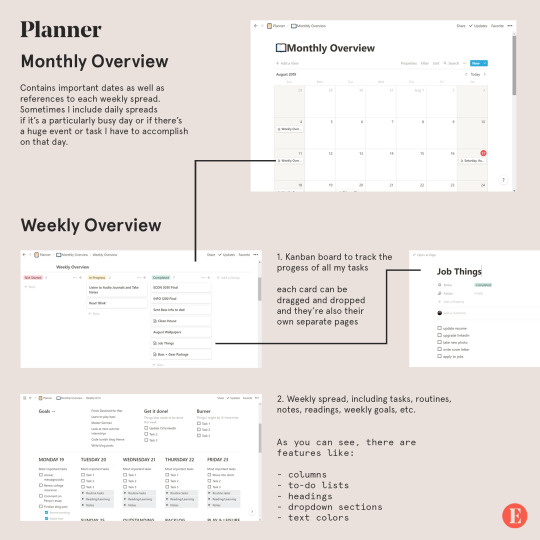
I also have entertainment lists, which is mainly a table with all the shows I want to watch, the books I want to read, etc. I keep track of whether or not I've watched them, as well as my personal ratings. What I love most about this is that each entry is its own page, so I can type my notes for each book, show, or film and easily find them in the future. (Also the reason why I have plural “lists” instead of just one entertainment list is because you can filter entries by type of entertainment, e.g. movies, tv shows, books, articles.)
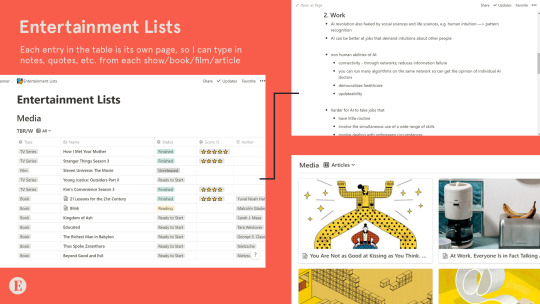
Personal
For personal notes, goals, journal entries, etc. This is kind of like an extension of my daily journal and just where I dump all my thoughts and keep track of the different aspects of my life: mental, emotional, spiritual, social, physical, and travel.
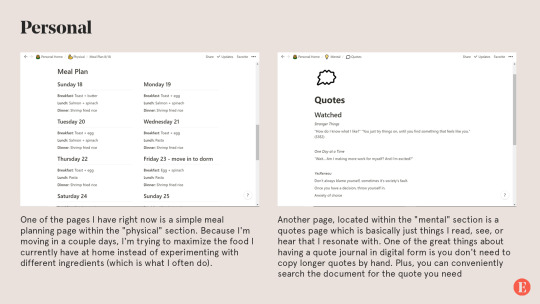
Another page I have is called "Stray Thoughts" and, well, it's pretty self explanatory. It's a lot easier to dump all my thoughts as they come and reorganize them later. Of course, this requires sacrificing the rawness of journaling, i.e. when the thoughts come and how you process them, which is why I still keep a regular journal that I write in daily.
Songwriting
I've been writing a lot of music over the summer and it's often hard to keep track of all of my songs and how far I've gotten in the songwriting process. So I created a table of songs - each entry of a song is a page with its lyrics. These are then tagged with the status of the lyrics (i.e. completed, in progress) and the status of the music itself (i.e. melody only, instrumental, mixing, mastering, revised). Eventually, I'll include demos in the database by embedding audio files in the document.
I have a separate section for inspiration and ideas, which is a kind of brain dump, e.g. words I think would make a good song, a certain theme for a song, a melody that's been stuck in my head, a vibe I'd like to try out, etc.
I've also been watching a lot of tutorials for music production and there's a section where I write my notes for that.
Eintsein
The last section of my Notion app is for this blog. Which has pages for
New posts. These are ideas for future posts, asks that I think would need longer answers, as well as posts that are currently in the draft stage (like this one was before I posted it)
Design assets. This is where I put all the visual branding material for Eintsein.com to be used in posts and any visual material on the blog.
FAQ. Having an FAQ document just makes it so much easier to make changes to your existing FAQ. Plus, if you ever change your FAQ theme, you just have to copy and paste what you already have.
Post directory. I keep track of all my previous masterposts, infographics, and generally longer and more comprehensive posts. It's the exact same as what you see on my Navigation page. And yes, the document contains direct links to the post.
New theme. A project I've been working on the past couple days is trying to create my own theme for my blog. This is where I put all my outlines, brainstorming notes, design inspiration, code snippets, etc.There are some pretty awesome features I’ve made use of in this page:

As you can probably tell, I'm absolutely obsessed with Notion since it has such awesome features and endless possibilities for customization. So far I've been using Notion for personal projects, which, since they are quite big in scale and have no set deadline, are important to organize well. My summer courses were only 6 weeks and weren't difficult to organize.
The formats above are just how I personally use notion. You could make some of your own, or if you don't think you want to build your pages from scratch, there are tons of templates to choose from. Here are some I think I'll be using in the near future and may be helpful for others as well, especially students like myself:
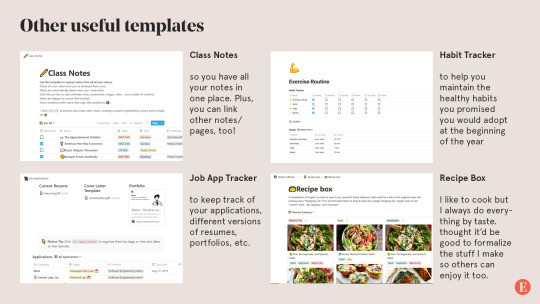
One drawback, however, is that Notion has a rather steep learning curve, but there are tons of tutorials online (especially YouTube) and I guarantee you it's all worth it.
Notion is not just a productivity app. It's a way to concretize your entire life.
Notion is free to use, but there are higher tiers that allow for more blocks, greater file size, etc. I use a personal account, which is $4 per month with unlimited block storage and no file upload limit (although I got it for $33/year). Personally I think the free plan would suit most people's needs, especially if you're not uploading large files.
#mine#eintsein#mymp#notion#apps#productivity#studyblr#studyspo#study hard#organization#document#graphic#design#infographic#masterpost#advice#tips
5K notes
·
View notes
Text
Jobmonster - Job Board HTML Template
Jobmonster – Job Board HTML Template
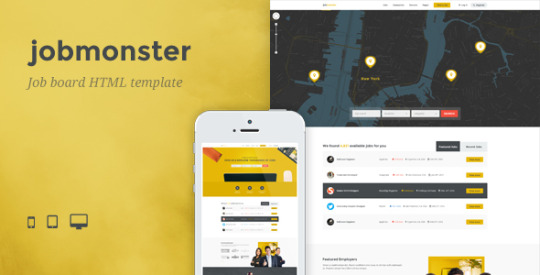


Jobmonster is an advanced Job Board HTML Template with a modern, clean, intuitive, and fully responsive design, that looks perfect on any size tablet or mobile screen.
The theme is completely covering needs of employers and candidates. We are bringing on the table absolutely new features, including Responsive and Retina ready; Built with Bootstrap 3, HTML5 and CSS3, 4 Home Styles, 4 Predefined…
View On WordPress
#Jobmonster#imdb wordpress theme#imdb for wordpress nulled#imdb wordpress template#tmdb wordpress theme#free wordpress theme download website#website theme for it company#wordpress theme for job website#wordpress theme for job portal website#best wordpress theme for job website#Board#HTML#Job#Template
0 notes
Text
Digital Signage Software - The New Twist to Communication | PiXLSIGN
Digital Signage is quickly emerging on the scene because it has eased the way we can conduct business or entertain ourselves, today. Both business and communication now rely on digitalized communication and implementing digital signage solutions one can do the job very well. The software used in digital signage is for content creation, content management and effective content distribution despite locations Digital signage software is deemed to be the future of the content management & advertising in public areas as well as in offices.
Cloud digital signage software integrated with indoor LED display screens allows smooth flow of information sharing among the audience. These display boards can either broadcast useful company information to the public or keep them entertained while the users wait in long queues at a public place like a banks, theatres, hospitals, restaurants, etc.Depending on the use, the software offers greater flexibility and scalability, as the content is stored, updated, and broadcasted from the cloud storage. Subsequently, managers can display content effortlessly, anytime and anywhere on the screens.

With the Digital Signage software, data customization allows to distinguish the content as per the designing templates (to be displayed on the LED screen) and as per the time schedule that matches the marketing efforts.Unlike fixed content in print, information displayed from the digital software can be used to change it dynamically and resources can often be ignored in this case. Moreover, with automated schedules and updates, no maintenance cost is involved in replacing the old data with new. All this adds up to low cost and saves time. Within seconds, the display is changed and new data can be displayed from the cloud service.
Cloud digital signage software solutions help in advertising. It supports brands, restaurants, retailers, facility managers &more to connect with potential customers and attract audiences with powerful advertising and informational subject matter. There is no limit of content that you can play in the digital signage that includes images, videos & HTML. Single online dashboard has the ability to control what is playing across screens. PiXLSIGN Digital Signage System provides simple and powerful cloud-based digital signage Solutions to manage and publish content for any screen. Our tool helps to express your creativity and content creation solutions. Get it now!
For more information please visit our website: Pixlsign.com
1 note
·
View note